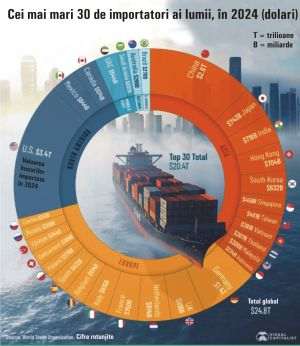The planet's debt calculated by the International Institute for Finance (IIF) amounts to 217 trillion dollars, according to data it has published, quoted by zerohedge.com. The website notes at the end of 2016, the global debt amounted to approximately 325% of the world's GDP.
According to the mentioned data, the debt of emerging countries has substantially increased, as the issues of government bonds and syndicated loans have increased almost three times in 2016, compared to 2015. The IIF writes that, out of a total of debt issues of 855 billion dollars last year, China accounted for the biggest chunk, of 710 billion dollars.
The numbers communicated by the IIF are somewhat suspicious, since the planet's debt cannot be calculated accurately, as the IMF itself states that it cannot provide this kind of data because of the different methodologies used by the various countries, as well as because there are countries that do not communicate the data, leaving blank spots on the debt map.
According to the analysis performed by BURSA, in 2011, on the internet, the global debt stood at 1.16 quadrillion dollars.
But the source wasn't reliable.
At the time, the planet's GDP was 51.1 trillion dollars (a certain number communicated by the IMF).
Later, in 2014, BURSA found two other alternate figures for the planetary debt, one from the Bank of International Settlements, (BIS), which amounted to 140 trillion dollars, and another that was calculated by BURSA based on an evaluation by ING Bank, amounting to 257 trillion dollars.
The uncertainty around that number persists.
What is worth noting though, is that this number representing the global debt which has concerned our newspaper years ago, has now become one of the concerns of the IIF; the number is useful in order to compare it with the GDP of the planet, in order to suggest whether or not the planet is financially solvent.
From the very beginning, when we find that the planet's debt could reach a ratio of 325% of the world's GDP, we are left with the impression that the planet is insolvent.
Still, neither the debt in itself, nor its ratio to the GDP can serve as the basis for a conclusion set in stone. On the other hand, if we compare the curve of the global debt to that of the global GDP, we find that the two are diverging and that the global debt is rising steeply.
Only now can we be certain that the planet is either insolvent or heading towards default.
The IIF warns about the rise of borrowing costs following the US presidential elections, which took place on November 8th, and of other pressures, including an environment with modest growth and low corporate profitability, with a strong American dollar, with rising sovereign bond yields, with higher hedging costs and with the deterioration of companies' solvency ratios - factors which have represented challenges for debtors.
Moreover, according to the IIF, those vulnerabilities are compounded by governments' reorientation towards increasingly protectionist policies, which could put pressure on the global financial flows.
"Moreover, the risks could increase as City of London is of major importance in the issue of bonds and on the derivatives markets, especially for companies in Europe and the ones on the emerging markets, and the schedule and the nature of the Brexit process are full of uncertainties", the IIF notes, referring to the rise in borrowing and hedging costs.
The IIF report stresses that the government debt has accounted for almost 50% of the global debt in 2016.













































